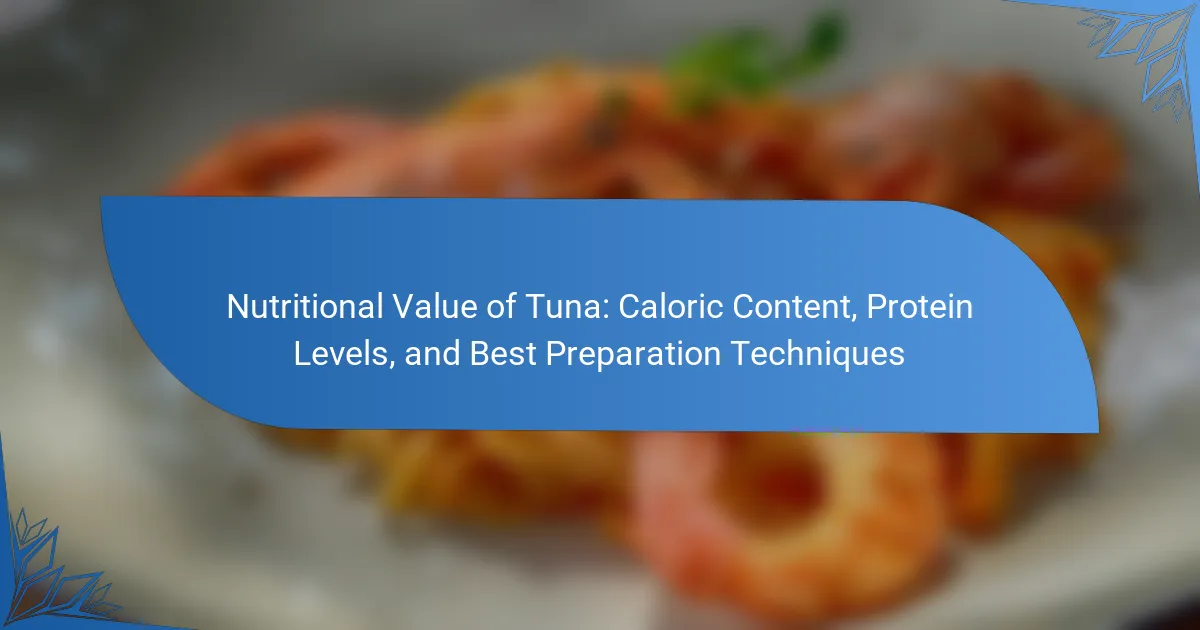
What is the Nutritional Value of Tuna?
Tuna is a highly nutritious fish. It is an excellent source of protein, providing approximately 25 grams per 100 grams. Tuna is also low in calories, with around 130 calories per 100 grams. Additionally, it contains healthy fats, particularly omega-3 fatty acids, which are beneficial for heart health. Tuna is rich in vitamins and minerals, including vitamin D, vitamin B12, and selenium. These nutrients contribute to various bodily functions, including immune support and energy metabolism. The nutritional profile can vary slightly depending on the type of tuna, such as albacore or skipjack. Overall, tuna is considered a healthy dietary choice.
How is the caloric content of tuna determined?
The caloric content of tuna is determined primarily by its protein and fat content. Tuna is a high-protein fish, with approximately 20 to 25 grams of protein per 100 grams. The fat content varies depending on the type of tuna. For example, canned light tuna has about 1 gram of fat per 100 grams, while fresh bluefin tuna can have up to 15 grams of fat per 100 grams.
To calculate the caloric content, the protein provides about 4 calories per gram, and fat provides about 9 calories per gram. Therefore, the total caloric value is derived from the sum of calories from protein and fat. For instance, a 100-gram serving of fresh bluefin tuna can contain around 200 calories due to its higher fat content.
These values can fluctuate based on preparation methods and added ingredients. Cooking methods such as grilling or steaming do not significantly alter the caloric content, but adding oils or sauces can increase it. Nutritional databases and food labels provide standardized caloric values for different tuna types and preparations, ensuring accurate measurements.
What factors influence the caloric content in different tuna species?
The caloric content in different tuna species is influenced by factors such as species type, fat content, and environmental conditions. Species like bluefin tuna have higher fat content, leading to more calories. In contrast, species like skipjack tuna are leaner and have fewer calories. The age and size of the tuna also affect caloric content, as larger fish typically have more fat reserves. Additionally, the diet of the tuna influences its fat accumulation and, consequently, its caloric value. Environmental factors, such as water temperature and availability of food, can impact growth and fat storage in tuna. These aspects collectively determine the caloric density of various tuna species.
How does cooking method affect the caloric value of tuna?
Cooking method significantly affects the caloric value of tuna. Different methods can either add or reduce calories. For example, frying tuna increases its caloric content due to added oils. Grilling or baking typically preserves the natural caloric value without additional fats. Boiling or steaming tuna may result in lower caloric values as these methods do not involve added ingredients. The overall caloric difference can vary by 50 to 100 calories per serving based on the method used. Thus, preparation technique plays a crucial role in determining the final caloric content of tuna.
What are the protein levels found in tuna?
Tuna contains approximately 20 to 25 grams of protein per 100 grams. This high protein content makes tuna a popular choice for those seeking to increase their protein intake. The specific protein levels can vary slightly based on the type of tuna and preparation method. For instance, canned tuna typically has around 23 grams of protein per 100 grams. Fresh tuna steaks may provide similar or slightly higher protein levels. Tuna is also considered a complete protein, meaning it contains all essential amino acids. This quality further enhances its nutritional value for muscle repair and growth.
How do protein levels vary between different types of tuna?
Protein levels vary among different types of tuna. For instance, bluefin tuna contains approximately 30 grams of protein per 100 grams. Yellowfin tuna has around 25 grams of protein per 100 grams. Albacore tuna offers about 23 grams of protein per 100 grams. Skipjack tuna generally provides around 22 grams of protein per 100 grams. These variations arise from the species’ biological differences and their respective diets. The protein content can also be influenced by factors such as age and habitat. Consuming tuna can be beneficial for protein intake due to its high levels across species.
What are the health benefits of the protein found in tuna?
The protein found in tuna offers several health benefits. Firstly, it supports muscle growth and repair due to its high-quality amino acid profile. Tuna protein contains essential amino acids that the body cannot produce on its own. This makes it a complete protein source. Additionally, tuna protein aids in weight management. It is low in calories and high in protein, which promotes satiety. Consuming protein-rich foods like tuna can reduce overall calorie intake. Furthermore, tuna protein contributes to heart health. It contains omega-3 fatty acids, which are beneficial for cardiovascular health. Studies show that omega-3s can lower blood pressure and reduce triglycerides. Lastly, tuna protein supports immune function. Proteins play a crucial role in the production of antibodies. This enhances the body’s ability to fight infections.
What are the best preparation techniques for tuna?
The best preparation techniques for tuna include grilling, searing, and poaching. Grilling tuna enhances its natural flavor while providing a smoky taste. Searing tuna quickly cooks the outside while keeping the inside rare, preserving its tenderness. Poaching tuna in broth or water maintains moisture and is a healthy option. Each method retains the fish’s nutritional value, including high protein levels and omega-3 fatty acids. For example, grilled tuna can have about 30 grams of protein per 100 grams serving. These techniques are commonly used by chefs for optimal taste and texture.
How does preparation method impact the nutritional value of tuna?
Preparation methods significantly impact the nutritional value of tuna. Cooking methods such as grilling, baking, or steaming can preserve more nutrients compared to frying. Frying often adds unhealthy fats, which increases caloric content. Canned tuna retains protein but may have added sodium, affecting its overall nutritional profile. Raw tuna in sushi maintains its omega-3 fatty acids, while cooking can reduce these levels. Additionally, overcooking tuna can lead to nutrient loss, particularly B vitamins. Each preparation method alters the balance of nutrients, making some methods healthier than others.
What are some popular cooking methods for tuna?
Popular cooking methods for tuna include grilling, searing, baking, and poaching. Grilling enhances the flavor and gives a smoky taste. Searing creates a crispy outer layer while keeping the inside tender. Baking is a healthier option that retains moisture. Poaching is a gentle method that preserves the fish’s delicate texture. Each method can highlight tuna’s nutritional benefits, including high protein content and low calories.
What are the common misconceptions about tuna’s nutritional value?
One common misconception about tuna’s nutritional value is that all tuna is high in mercury. While certain species, like bigeye tuna, do contain higher mercury levels, others, such as skipjack, have lower mercury content. Another misconception is that canned tuna lacks nutritional benefits. In reality, canned tuna retains most of its protein and omega-3 fatty acids. Some people believe tuna is not a good source of vitamins. However, tuna is rich in B vitamins, particularly B12 and niacin. Additionally, there’s a belief that tuna is only beneficial when fresh. Both fresh and canned tuna offer significant health benefits, including high protein content and essential nutrients.
Why do some people underestimate the health benefits of tuna?
Some people underestimate the health benefits of tuna due to misconceptions about its nutritional value. Many individuals believe that all fish are equal in health benefits. However, tuna is particularly rich in omega-3 fatty acids, which are essential for heart health. A 3-ounce serving of tuna contains about 20 grams of protein and significant amounts of vitamins and minerals. Additionally, concerns about mercury levels in tuna may lead to avoidance, overshadowing its benefits. Research indicates that the health advantages of consuming tuna outweigh the potential risks when eaten in moderation. Therefore, the nutritional profile of tuna is often not fully appreciated.
How can understanding tuna’s nutritional value improve dietary choices?
Understanding tuna’s nutritional value can significantly enhance dietary choices. Tuna is rich in essential nutrients, including high-quality protein, omega-3 fatty acids, vitamins, and minerals. Consuming tuna can support muscle growth due to its protein content, which averages about 25 grams per 100 grams of fish. Omega-3 fatty acids in tuna, such as EPA and DHA, are linked to heart health and reduced inflammation.
Additionally, the low caloric content of tuna, approximately 130 calories per 100 grams, makes it a suitable option for weight management. Knowledge of these attributes allows individuals to make informed decisions about incorporating tuna into a balanced diet. Studies show that regular consumption of fish, including tuna, may lower the risk of chronic diseases. Understanding these nutritional aspects can guide healthier eating patterns and promote overall well-being.
What are practical tips for incorporating tuna into a healthy diet?
Incorporating tuna into a healthy diet can be achieved through several practical tips. First, choose canned tuna packed in water for lower calories and fat. Second, limit consumption of tuna to 2-3 servings per week to avoid mercury exposure. Third, combine tuna with whole grains like brown rice or quinoa for balanced meals. Fourth, add fresh vegetables to tuna salads for extra nutrients and fiber. Fifth, use olive oil or Greek yogurt instead of mayonnaise for healthier dressings. Sixth, experiment with different spices and herbs to enhance flavor without added calories. Lastly, consider using tuna in wraps or sandwiches with whole grain bread for a nutritious lunch option. These tips ensure that tuna can be a beneficial part of a healthy diet while maintaining variety and flavor.
The primary entity of this article is tuna, a highly nutritious fish known for its significant protein content and health benefits. The article provides an in-depth analysis of tuna’s nutritional value, including its caloric content, protein levels, and the impact of various preparation techniques on its health benefits. Key topics include the differences in protein and fat content among tuna species, the effects of cooking methods on caloric value, and common misconceptions about tuna’s nutritional profile. Practical tips for incorporating tuna into a healthy diet are also discussed, emphasizing its role in promoting overall well-being.



